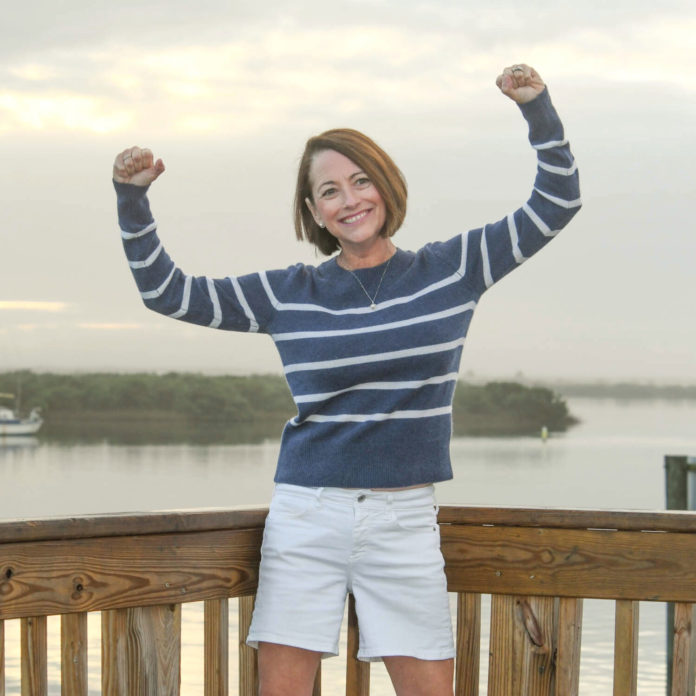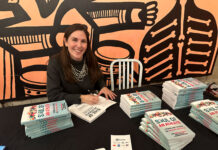Stephanie Feller had felt pressure around her nose for some time, something wasn’t right. She brushed it off, chalking it up to a sinus infection. Later in January of 2018 she and her husband, Rick, were in the Galapagos Islands when a knot appeared on her neck. Steff was perplexed, but not overwhelmingly concerned. Once back home, she set up a doctor’s appointment. “My doctor said it was most likely another sinus infection.” This was a common theme from the previous two years as Steff was repeatedly diagnosed with allergies and multiple sinus infections.
Two weeks later her symptoms hadn’t improved. She returned to her doctor, who prescribed another round of antibiotics. A couple of weeks later when celebrating St. Patrick’s Day at McCormick’s tent in Wayzata, her close friend Stacia said, “Steff, what is going on with your neck?” Steff explained her doctor said it was most likely an inflamed lymph node from a sinus infection. “Stacia had a suspicion it may be more serious,” Stephanie explained. “She encouraged me to have it tested. The next day I set up another appointment and because I asked for it I was scheduled for a CT scan right away. I didn’t even tell Rick because I didn’t think it was a big deal.”
The Turning Point
While chatting away with the technicians before and during the CT scan, Steff hadn’t noticed when the room fell quiet. As she came out of the tube, she realized the technician wouldn’t look her in the eye. “The techs couldn’t read the scans for me, but they did see what was going on. I learned later metabolically active cells lit the scans up.” Stephanie had a marble-sized tumor at the base of her skull, her optic nerve, and nasalpharynx.
“It had probably been there a fairly long time,” Steff said matter of factly. “It had progressed to my lymph nodes, which was a problem.” Her general practitioner referred her to an ENT who through a biopsy confirmed the presence of Nasopharyngeal cancer, a rare type of head and neck cancer. Steff was then referred to an oncologist who, in less than a week from the initial CT scan, advised proceeding with Intensity-modulated radiotherapy (IMRT) and chemotherapy. “Think of your tumor as the middle of a target. The target is red, then there’s the next ring which is yellow, the next ring green – those are the margins. With IMRT they have to target all the margins, that’s quite a wide range. Radiating all of that would have potentially left me with vision loss, with hearing loss, no taste, no smell, that’s the effect the protocol often produces, horrible lifelong side effects. The oncologist wanted to start treatment immediately and even went so far as to request we get the radiation mask fitted that day. Troubling to us, this doctor had never treated my kind of cancer.”
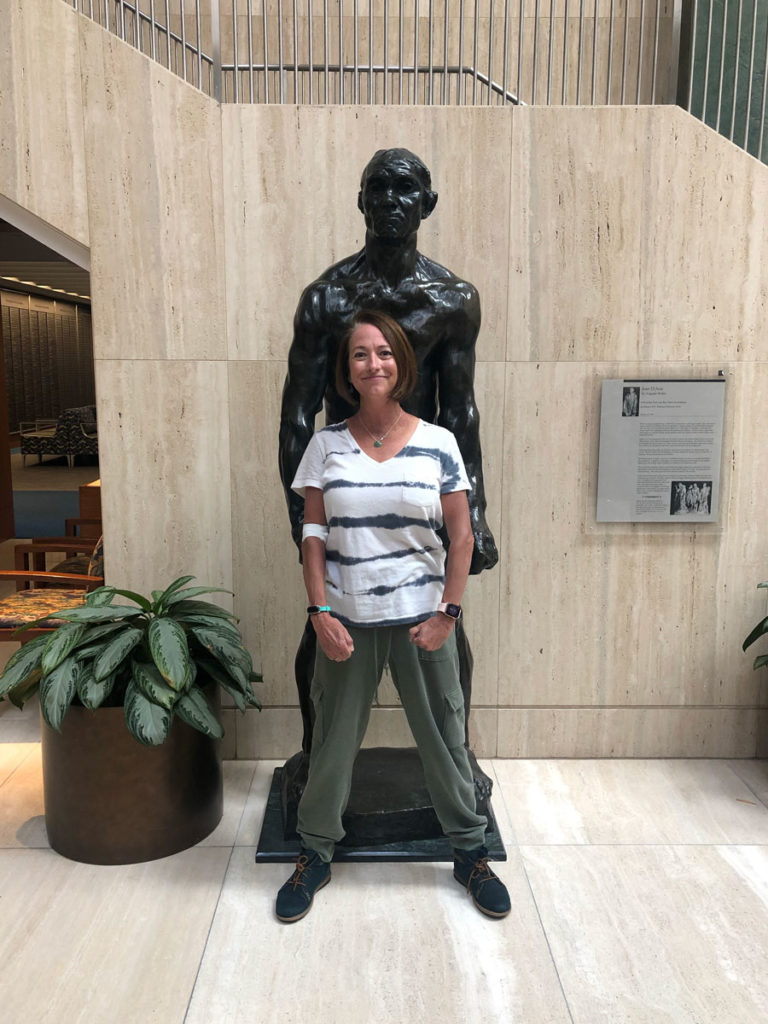
The Mayo Clinic
Rick was adamant they get a second opinion and suggested the Mayo Clinic in Rochester. There they saw Dr. Daniel Ma who recommended Proton Radiation Therapy instead of IMRT. At the time, Rochester was one of the few hospitals offering Proton Radiation (as of this writing there are currently 29 centers offering Proton Radiation in America). “It is the best radiation because it has the least collateral damage for the high-priced real estate in your head. Surgery was not an option. Dr. Ma explained in order to leave me with some saliva, he would pinpoint the radiation to avoid my salivary glands.
“We decided to go with Mayo. We are fortunate enough that we had the resources to relocate to Rochester for three months so I could receive daily radiation treatments and every three weeks high dose chemotherapy. Described by doctors as one of the harshest if not the harshest combinations any doctor in the world would ever prescribe. We were hitting it hard.
Roadblock
“It turned out Nasopharyngeal cancer is so rare, there haven’t been enough people to vet results to change the protocol recommending IRMT,” Stephanie explained. “So at 4:00 pm the day before the scheduled start of treatment, the financial office at Mayo called with news that our insurance wouldn’t pay for the Proton Radiation. In order to proceed the next day as scheduled, we needed to pay the $280,000 upfront, in full.” The person who called recommended she proceed with the IMRT treatment since insurance would cover it. “But I wanted to see! I wanted to hear! To taste, to smell! What kind of life would I have otherwise?” Steff’s eyes were big as she described the thoughts that passed through her mind. Then her husband moved mountains. Rick was on task, doing whatever he could. Within 14 hours he handed over to Mayo a check in full, as directed. “The doctors were shocked, they said no one had ever done that! Rick is truly my superhero.” Treatment began as originally scheduled. Eventually, the Fellers were reimbursed by their insurance company after completing massive amounts of paperwork and phone calls over time.
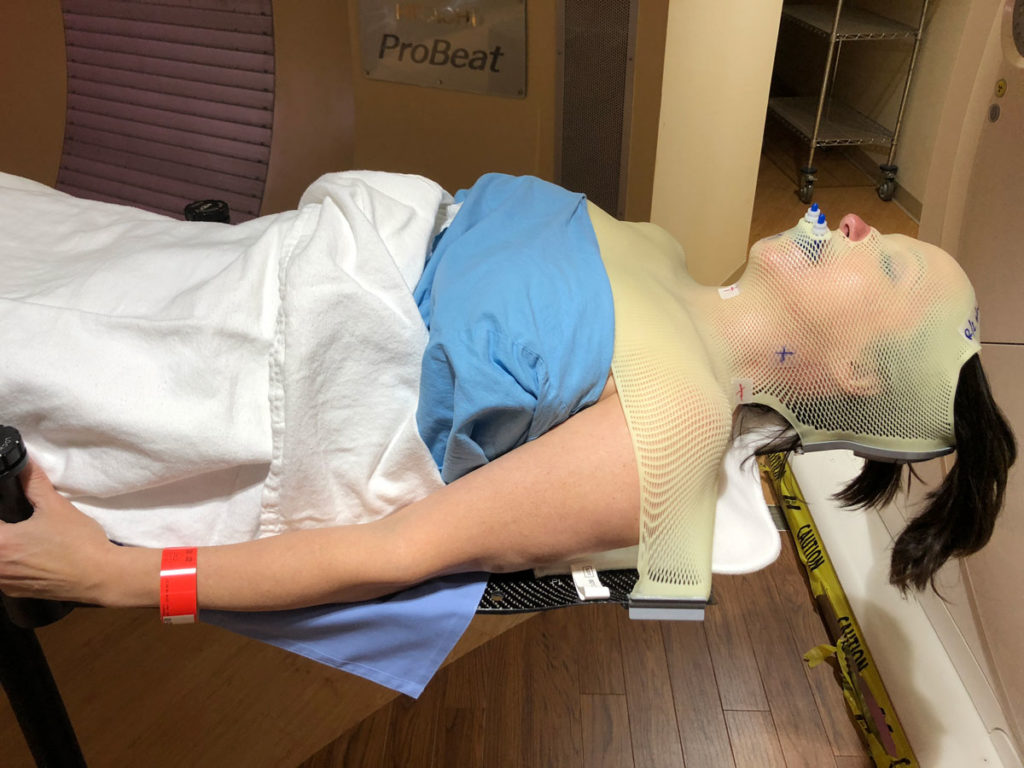
Treatments
For Steff, the real challenge began with the radiation and chemotherapy treatments. “A custom mask was made for me for my Proton radiation treatment. I had 35 rounds of radiation administered over seven weeks. Every day I was strapped to a board, placed in a tube with a plate in my mouth for an hour or more. The radiation machine is three stories tall and runs 24 hours a day. It’s like Star Trek, it’s one focalized beam. It pulses to hit all your fields before moving on to three more patients before coming back to you. If anyone had an issue, like nausea, or if one of the other people freaked out, it slowed the process down for everyone. The mask is worn to keep you from making any type of movement, the most infinitesimal movement off to the side could have potentially hit my jugular artery since there was a tumor precariously close to it.
“Through the treatment, I lost almost 80% hearing in my right ear, and 20% in the left. I have lost the ability to create saliva, and had difficulty swallowing. It did prove to be a tough treatment. They basically burn a person from the inside out and then apply chemo on top of that.” She had a feeding tube for seven months due to radiation burns in her mouth, creating blisters and inhibiting her ability to eat. “I can’t even describe how terrible it was.”
Social Media
Despite all the trauma she and her family were experiencing, to the outside world Stephanie was open and incredibly optimistic. “I had a CaringBridge page, but not everyone could access it,” Steff explains. “People were calling and texting, it was hard to have the same conversation five, six, or more times.” So she created a separate Facebook page and titled it, “Stellar Feller. I have cancer but cancer doesn’t have me. Warrior on.” It is here she gives updates on her treatments but keeps her personal Facebook page separate. “My personal page is about my life. “My cancer and my life ARE separate. I made the second page more for other people so everyone could know what was going on. People can opt out, but they were always asking what they could do for me, so on that page I ask for posts that make me happy and smile. One friend sends me a joke every Thursday, I look forward to it!” Steff pulls out her iPhone, reads me the polar bear joke that appeared the day of our interview and we both cracked up. “The power of Facebook can be used positively to bring support, comfort, and information to those in need.”
Drawing Strength
When asked what Steff did during her radiation sessions, she answered, “I listen to podcasts, mainly The Moth because it is an hour long. But also…” Steff pauses, smiles, then continues. “My grandfather died six months after Rick and I were married. He did not know a stranger, he would walk into any place and talk to anyone and everyone. He was that kind of guy, just a lovely, lovely man. When I was going through radiation, I was consciously talking to him. I imagined his face, I could hear him. I visualized. I’ve always been positive and outgoing, I know I got that from him. I took comfort in talking to him.”
A Gift
“Cancer takes away the fear. I could care less what people think of me now. I was talking with a lady the other day who said she questioned everyone’s response towards her, she wondered what people thought of her. ‘What a terrible way to be!’” Steff exclaimed, to which the lady’s response was, “Well everybody is like that.” “No, no, no,” Steff answered. “I don’t have the energy to be like that. You realize what’s important, to say hi to people, to compliment someone, to tell a joke, if you see something good in the world, POINT IT OUT!
“Prior to this I was more fearful of reaching out to people that way. I just don’t care anymore. It is a gift of cancer, it puts your mind in a different space. We’re all in this together. You can choose how you live your life.”
Burghers of Calais
Near the large cafeteria in the subway level of the Siebens Building stands Auguste Rodin’s statue of Jean D’Aire, a man who saved the city of Calais, titled Burghers of Calais. “The stoic and emotional stance of this man is really moving to me. For me, he symbolizes how people meet challenges with vitality, passion, and suffering, which is especially meaningful at a medical center where patients, staff, and visitors confront some of life’s most difficult situations. There is a grand piano positioned next to this statue. I like to play the piano, it relaxes and calms me, I often find myself playing during my downtime. During my last visit, I sat down and played Christmas music as I waited for an hour and a half between my bloodwork and chemo. A guy came up afterward and thanked me, it made me feel so good! Mayo has artwork everywhere, there is original Chihuly glass displayed throughout the building ~ it makes me happy! Andy Warhol originals have also been donated. Mayo believes in healing the whole person, physically, emotionally, and spiritually. They are incredible.”
Recurrence
This past July 2019 the Fellers received news a recurrence had been detected. “We didn’t do anything.” Stephanie described their decision to wait a while, to process the information. Then in October they opted to try Keytruda, an immunotherapy treatment. The cancer was in her lungs, her lymph nodes, and around her heart. “My largest spot is 5 millimeters, which is tiny.”
After a botched attempt to extract a tissue sample (a five-minute procedure that turned into an hour), Stephanie was told the doctors needed to go in again. “I said, ‘If you’re going to get it, get a big enough sample so parts can be sent to MD Anderson, Sloan Kettering, and Stanford.’” It was important to Steff for enough tissue to be taken for multiple research hospitals to learn as much as possible, to help as many as possible.
Medical Team
Dr. Ashish Chintakulawar (affectionately known by Steff as Dr. C) brought in Dr. Katharine Price, another oncologist whose area of specialty is head and neck cancer. “I told them it’s about quality of life, not quantity. If we do nothing I have six months. If we treat something it could be 10 years. They just don’t know — I do know I don’t want to feel like I did the first round of treatment, that’s not living. I am hopeful they aren’t going to radiate me this time, we’re going through with chemo, my schedule is set for the next three months.
“Mayo is just the best,” Stephanie adamantly states. “We have been to many hospitals, and Mayo is just a machine. At the advice of my doctor, we’ve been to MD Anderson and Sloan Kettering and have been in contact with researchers at Stanford. To have a doctor who is willing to tell us to get a second opinion, not to have the hubris to say he knows everything, at that point I knew Dr. C really cared about me. Mayo is not overly experimental, they’re not often pushing the envelope on new technology. They are good at what they know works. I saw Dr. Dunn at Sloan Kettering, Dr. Mott at M.D. Anderson and now my doctors here, Dr. C and Dr. Price are talking with Dr. Dunn and Dr. Mott. They have a plan of different lines of treatment. The first line of treatment was chemo and radiation. The second was Keytruda, and now we’re onto the third with chemo and they have two more plans they’ve developed together. If that doesn’t work, hopefully there will be a new discovery of treatment.” I asked if Dr. Mott at M.D. Anderson and Dr. Dunn at Sloan Kettering had collaborated with the doctors at Mayo prior to this, to which Steff answered, “No, I introduced them. They communicate regularly now.” Stephanie has a gift for bringing people together.
No Regrets
“I asked Dr. C., ‘What should I do, how do I go forward? Is this the time you reach out to people and right wrongs?’ He said, ‘Yes. I’m not telling you that because you have cancer and you’re dying. I’m telling you that because that’s the way you should live. Don’t live with regrets.’ So I reached out to all my friends in Florida, I reached out to all my friends in Virginia, anyone on Facebook I hadn’t seen for a while, and anybody I’d had an issue with. I believe once you love somebody, you love somebody. A good friend and I hadn’t been talking to for a very long time. I said to her, ‘what the hell. I love you, and you love me, I know that.’ All the other stuff just fades away. I feel good. We’re all going to die, the only difference is I know my time frame is a little bit shorter.”

Supporting Cast
“Throughout all of this my sister Kelly took on a huge burden, she’s listened and taken care of things. Everyone should have a Kelly,” Steff said. “There have been many good things that come from my cancer diagnosis. I have deeper relationships – people really reveal themselves when confronted with cancer. “My son Sam (a junior at the University of Alabama) calls at least twice a day to check-in. Another friend brought me breakfast every day for two months. I have so many friends who have taken such good care of me, without their love and support I would never have endured. It truly is an amazing community and I am beyond BLESSED and THANKFUL for them all. And then there’s Rick. He’s a REAL LIFE SUPERHERO! If there’s a problem, he will fix it. That’s what he’s struggling with right now. He’s got the worst of it, burdening himself with this. He can’t fix this.
Shortly after learning of her recurrence, Steff and one of her closest friends, Amy Rychlick, were at a Vikings game. Steff shared the situation with Amy, and they had a cry together. When they were waiting in the parking ramp, the traffic was at a standstill. “You know, I don’t get upset or angry anymore about things like that.” When a BeeGees song came on in their car, Steff said to Amy, “Come on! Let’s go dance!” and they jumped out, gave Amy’s phone to a woman waiting in a nearby car, and asked her to tape them while they line danced, ironically, to the song, “Staying Alive.” Steff laughed, “Everyone was clapping and cheering!” When it was posted on Steff’s Facebook page, it received a viral-like response. “It made me happy. I had people sending me videos of their own dance, my friends from Virginia, Florida, Colorado, the girls (daughter Megan and her friends) in California. It was pretty cool.”
“My dad gave me his golden eagle pin he received when he received his colonel’s commission in the Air Force. It’s pinned on me each time I go to chemo. And my mom, a retired ICU nurse, despite all her physical limitations came up to Minnesota to put me on the right schedule of medicine and sleep and to provide a professional oversight to my care.”
“No one fights cancer alone, and for all the unnamed folks who have supported me, their contributions are equally as important. There are just too many to list.”
Choices
What strikes me is Steff’s ability to take what’s handed to her, digest it, share it, then move forward and not look back. When asked where she goes from here, Stephanie Feller responded, “No one chooses cancer, cancer chooses you. However, every person afflicted with this dreaded disease has the opportunity to choose how they handle the diagnosis. Choosing to remain positive is not only helping my mind, body, and spirit, it is beneficial to everyone connected to this cancer warrior.” Steff is sharing her love and strength just as the Rodin statue at the Mayo Clinic has impacted Steff.
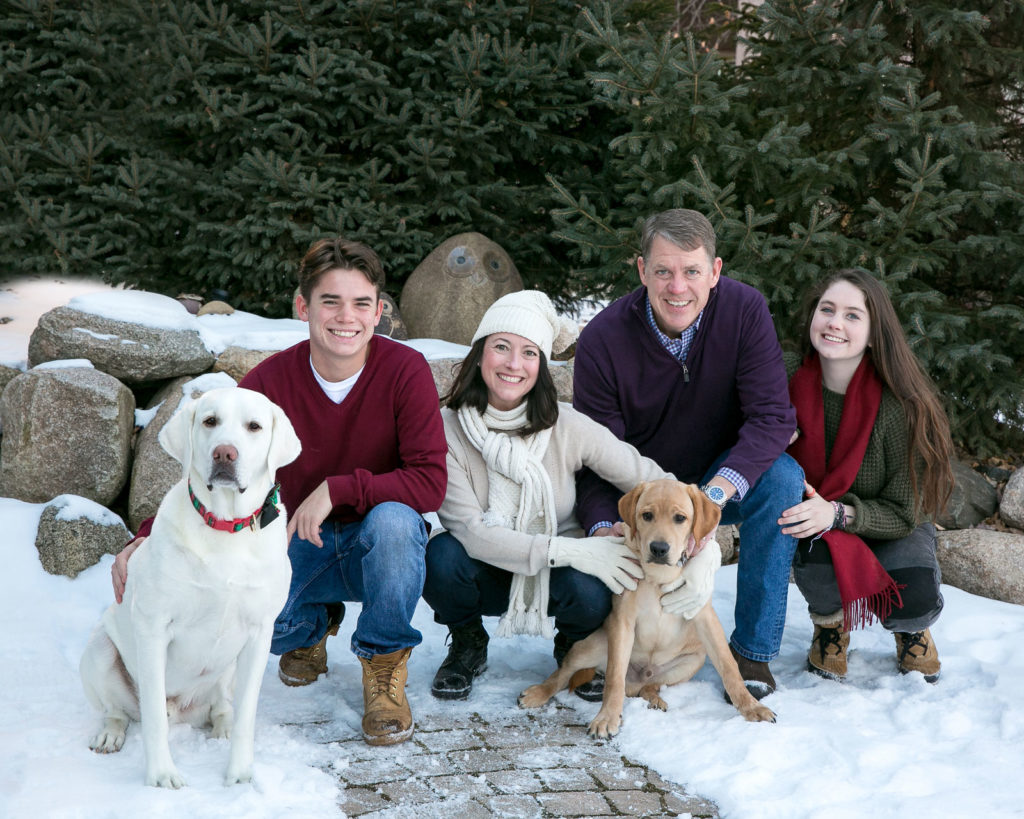
Her Words
In her last Facebook post of 2019 on her Stellar Feller page, Stephanie shared this message:
“I have always believed in energy, light, love and God. Call it what you will but I feel connected to each and every one of you. I don’t see many of you but I know in my heart you are rooting for me and wish me well, as I do for you. I don’t think that stops when someone dies.
“I can’t actually ‘see’ love but I can see evidence of it everywhere I look. I can’t see the wind but feel its cold bite almost every day. I can’t see the force that moves the waves across the sea, but I can stand in the ocean and be turned upside down by it. I see God all around me, not just in church, and feel comforted by the assurance that we are all in this together.
“Make it a beautiful day, and as one of my best friends says, ‘Live a Great Story.’ I know I am. ❤️”
Postscript: Stephanie’s main hesitation in sharing her story is receiving unsolicited advice.
Let’s please adhere to her wishes, instead keeping her in our thoughts and prayers as she continues on her journey towards healing. Steff wants to stress the importance of early detection, she emphasizes you know your body best. If something feels “off,” encourage your health care provider to keep investigating.



